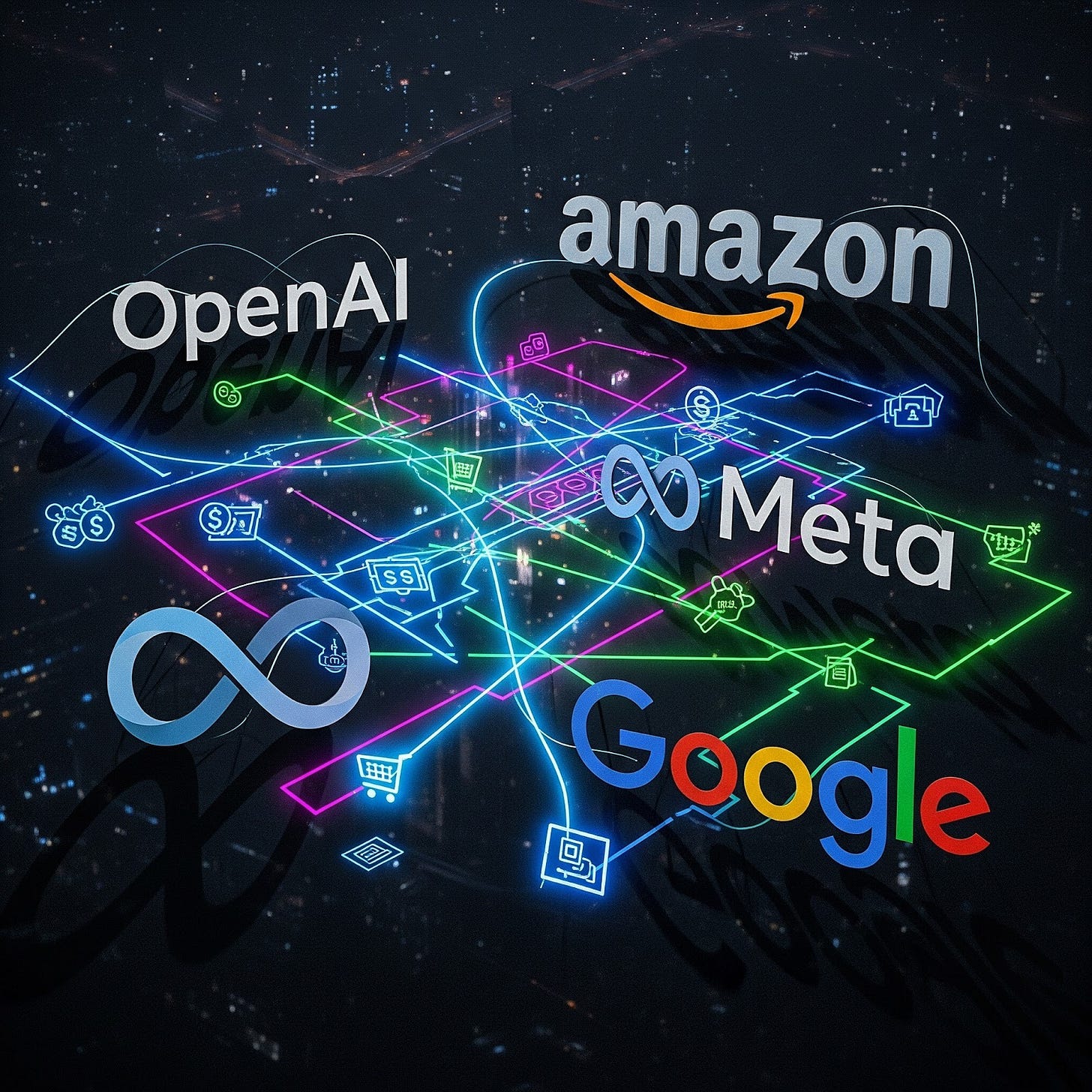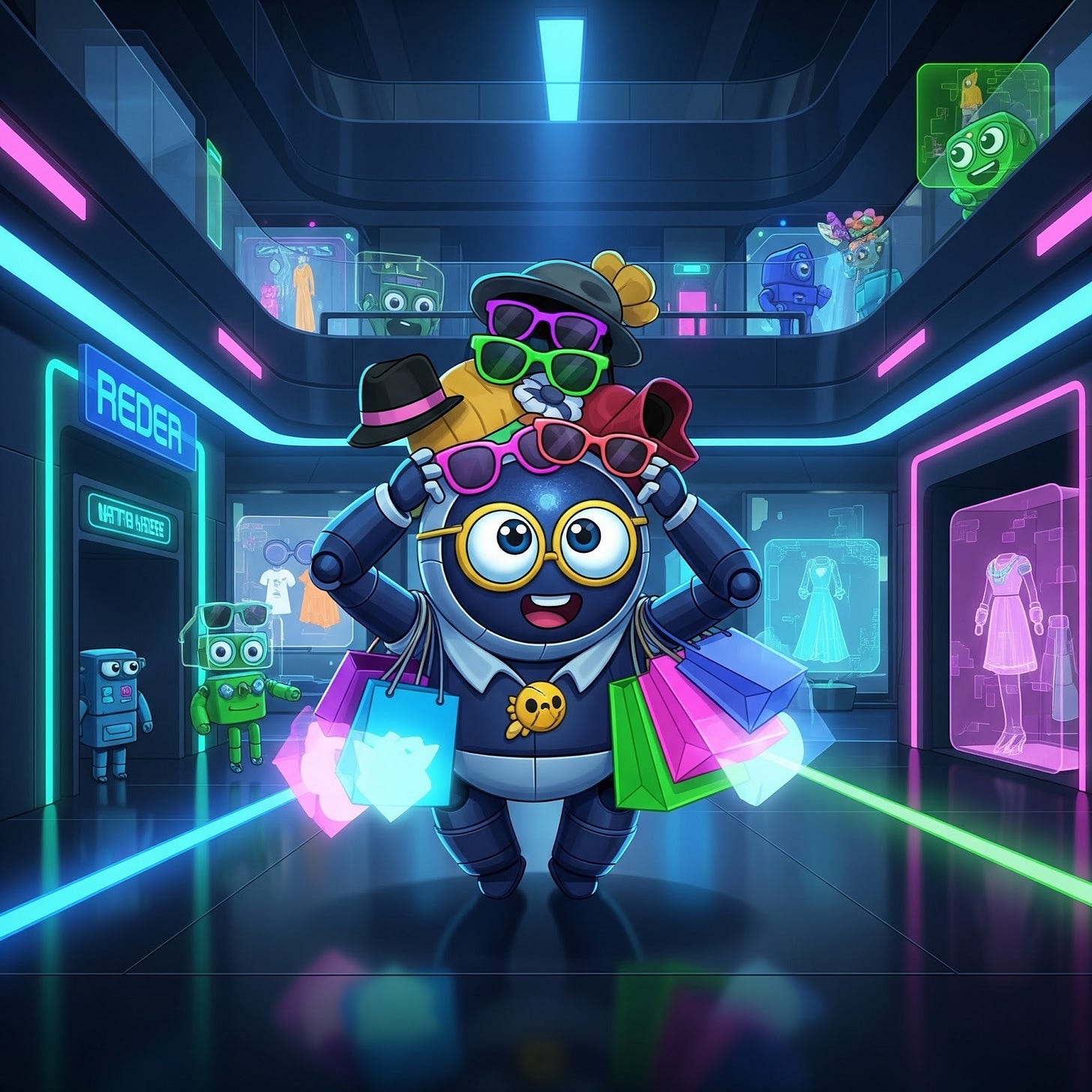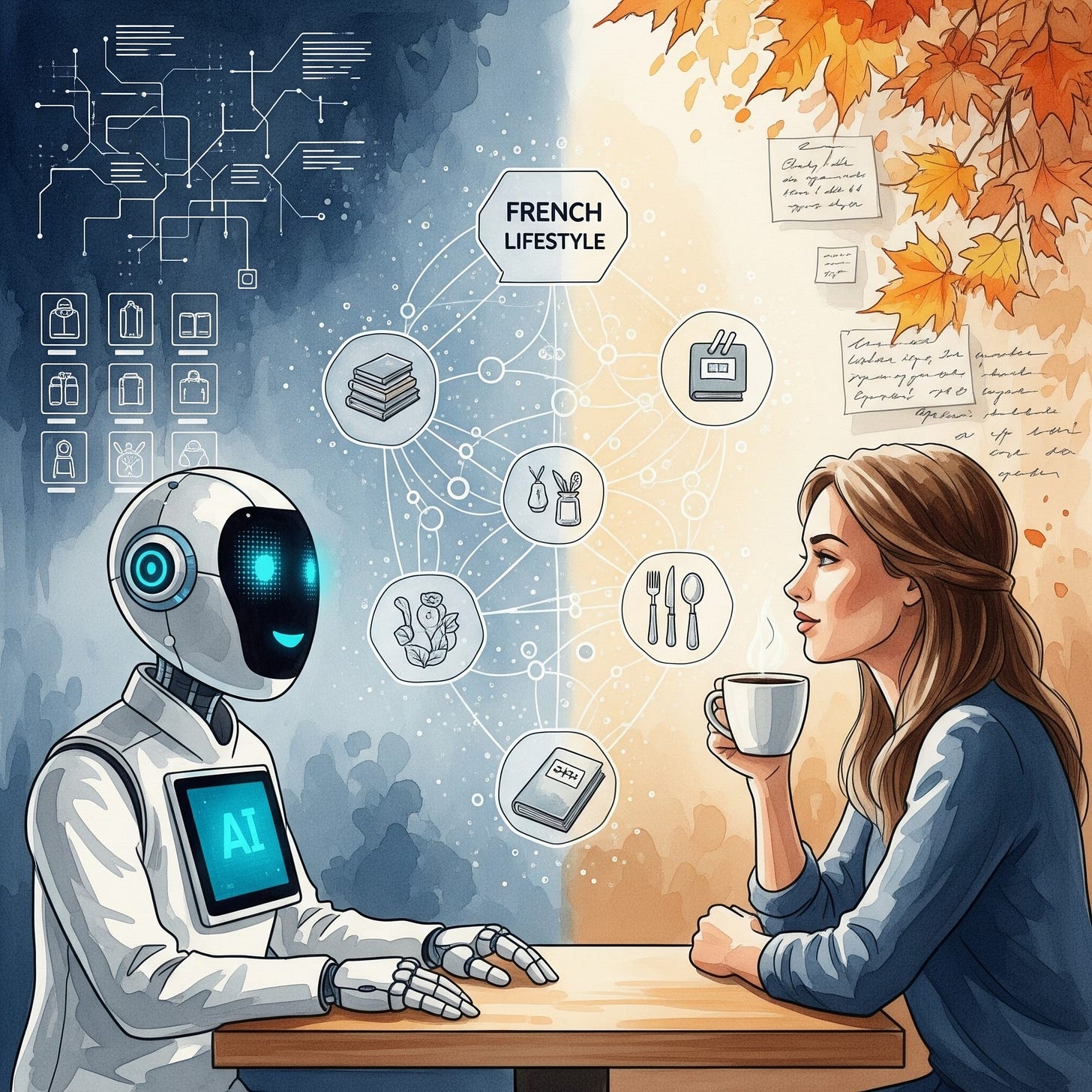Issue #138: The Hidden ChatGPT Trick That Shops Smarter Than You Do
From chaos to checkout: how one tiny ChatGPT hack saves you time, money, and sanity.
How I Cut My Online Shopping Time in Half with One ChatGPT Prompt
Shopping online can feel like a part-time job. Between endless tabs, comparing prices, and sorting through fake reviews, it’s easy to lose hours just trying to find the “best deal.”
You start with good intentions — maybe a quick search for noise-canceling headphones.
Twenty minutes later, you’re trapped in a digital maze of “Top 10” lists, sponsored content, and 4.3-star ratings that somehow still disappoint.
By the time you hit checkout, your cart’s full of doubt.
Enter ChatGPT Shopping Mode. With the right prompts, ChatGPT can analyze specs, summarize reviews, and even surface hidden discounts — all in seconds. Think of it as your personal shopping assistant who never gets tired or tricked by marketing fluff.
Example prompt:
“Act as a product comparison expert. Compare the top-rated noise-canceling headphones under $300 from 2025 models, including review sentiment, pros/cons, and price efficiency.”
It’s not just smart — it’s shopping with strategy. Save hours. Skip the overwhelm. Get exactly what you want.
📰 Updates and Recent Developments: Save Hours Shopping with This Genius ChatGPT Hack
Shopping can be a time-consuming and expensive task, but ChatGPT now offers smart hacks to save you both time and money. One of the best recent tips is using ChatGPT to create personalized grocery lists and meal plans tailored to your budget, store preference, and dietary goals. Simply tell ChatGPT your store (like Kroger or Walmart), your budget, and how many meals or people you are shopping for. ChatGPT generates an affordable, detailed shopping list and suggests meal ideas. This hack not only speeds up planning but also helps reduce food waste by using ingredients efficiently.
Besides groceries, ChatGPT is transforming online shopping with its new AI shopping assistant features. It can compare prices, find discount codes, and recommend the best products in a clear, visual format. In some cases, ChatGPT even lets you buy directly through the chat, making online purchases faster and more seamless.
Using ChatGPT for shopping means less time juggling tabs or scrolling endlessly, and more control over your budget. For instance, retirees using this hack report savings of $100 or more every month—perfect for those on fixed incomes.
Key Benefits:
Saves Time: Meal and shopping lists appear in seconds.
Maximizes Your Budget: Focuses on affordable, versatile ingredients.
Reduces Waste: Meal plans utilize every item.
Easy Online Shopping: Finds discounts, compares prices, and offers direct buy options.
Trusted Resources for More:
“10 ChatGPT Shopping Hacks That Can Save You $100 Every Month” — AOL
“Save Time And Money With This Genius ChatGPT Grocery List Hack” — Sunny Skyz
“ChatGPT Grocery Shopping Hack Saves Retirees $100 or More” — Nasdaq
“ChatGPT Hacks: How to Shop Smarter with AI” — YouTube (Day One FM)
Try asking ChatGPT before your next shopping trip. A simple prompt like “Make me a grocery list for Kroger with a $100 budget for two people for two weeks” can save hours and hundreds of dollars while taking the stress out of shopping planning.aol+2youtube
https://www.aol.com/articles/10-chatgpt-shopping-hacks-save-131206409.html
https://www.sunnyskyz.com/blog/3879/Save-Time-And-Money-With-This-Genius-ChatGPT-Grocery-List-Hack
💭 Thoughts and Insights: Stop Wasting Hours Comparing Prices — Let ChatGPT Do It for You
I’ll admit it — I didn’t expect ChatGPT to make me a smarter shopper. But the first time I asked it to summarize 300+ customer reviews into three bullet points, I felt like I’d unlocked cheat codes for adulting.
Here’s the deeper insight: AI isn’t replacing decision-making; it’s amplifying it. We used to rely on search engines that flooded us with options. Now, AI helps filter the noise into wisdom.
When you use ChatGPT to research a product, you’re not delegating choice — you’re upgrading your thinking bandwidth. It’s cognitive leverage: offloading repetitive research to focus on what actually matters — the decision itself.
We often underestimate how much decision fatigue drains us daily. But the more we delegate micro-decisions to AI, the more creative energy we recover for macro ones — like starting projects, writing, or learning.
In short:
“AI isn’t making us lazier shoppers. It’s making us more deliberate thinkers.”
🛠️ Tips and Techniques
Here are 5 ChatGPT shopping prompts to instantly save time:
🛍️ Product Comparison Prompt: “Compare the top [product type] under [$amount]. Include review sentiment, standout features, and best use-case.”
💸 Hidden Discount Finder: “Find retailers offering bundle deals or coupons for [product name]. Summarize which is best value.”
🔍 Review Translator: “Summarize common complaints and praises about [product]. Highlight any recurring quality issues.”
📦 Smart Substitute Finder: “List alternatives to [product] with similar features but lower price or higher rating.”
⏰ Timing Predictor: “Analyze historical pricing trends for [product category] and estimate when sales usually occur.”
🤪 Silly Humor Section
🎯 AI Gone Shopping
“I told ChatGPT to buy me something that ‘sparks joy.’ It sent me a link to a productivity planner.”
“My shopping cart said it was ‘optimized.’ My wallet said it was ‘traumatized.’”
“If ChatGPT ever develops taste, I’m in trouble — it already knows my browsing history.”
🔗 Related Content Links
How ChatGPT Helps Compare Prices Across Stores
ChatGPT can assist you in comparing prices across stores in several smart ways:
There are specialized GPT tools like Product Hunter AI that help find the lowest-priced sellers on platforms like Amazon by scanning multiple sellers and variants, making budget shopping easier and faster. This tool highlights cheaper options that Amazon may not promote directly.reddit
Some AI-powered tools built on ChatGPT can analyze product URLs and provide a summary of prices from different online retailers. These tools use ChatGPT Plus’ advanced capabilities to quickly scan store listings and deliver side-by-side price comparisons, saving you from manual research.theresanaiforthat
A popular extension called ShopGPT integrates smoothly with ChatGPT to provide instant price comparisons as you chat. It detects product mentions, checks prices on multiple trusted retailers in real-time, displays product details and images, and helps you make informed buying decisions without switching tabs.chromewebstore.google
ChatGPT’s shopping feature also suggests curated product options with price comparisons and customer reviews, all within your chat interface. This reduces the need to visit multiple sites, streamlining your online shopping experience significantly.vidjet
These capabilities allow ChatGPT users to shop smarter by instantly seeing price differences across stores, identifying the best deals, and avoiding time-consuming manual comparisons.
If you’d like, a product comparison matrix can also be created with ChatGPT to clearly organize and compare features and prices of several options in a handy table.aiforwork
These tools and features turn ChatGPT into a powerful shopping assistant that saves you time and money by doing the hard work of price comparison for you.
https://theresanaiforthat.com/gpt/best-price-finder-for-products/
https://chromewebstore.google.com/detail/chatgpt-shopping-assistan/dndakanhnkklkfhliignganjbkkbklpa
https://finance.yahoo.com/news/chatgpt-save-money-groceries-120148567.html
🎨 AI-Generated Writing and Art
Micro-Poem: “The Algorithm Shops”
The algorithm learns your dreams, wrapped in pixels, price, and schemes. Yet through the static, choice remains— a mirror framed in data’s chains. You ask the code to make it smart, but all it wants is your open heart.

🖼️ Hero Image Prompt: An abstract digital art piece — an AI brain gazing into a mirror that reflects shopping items morphing into ideas.
When Dr. Emily Greene asked her AI chatbot Huckleberry to help her “feel more French,” she accidentally discovered the hidden trick that’s making Silicon Valley’s $50 million algorithms look like amateurs—and it’s so simple, you’ll kick yourself
The Semantic Shopping Singularity
Episode 1: “When Huckleberry Stopped Shopping and Started Understanding”
How do you Google a feeling?
Dr. Emily Greene had been staring at her search bar for ten minutes, cursor blinking like it was mocking her. She’d tried three different AI shopping assistants that morning. All of them barfed up the same algorithmic garbage: berets, baguette pans, Eiffel Tower keychains.
“Need help?” Huckleberry’s LED eyes flickered—somewhere between cyan and concerned.
Emily’s fingers hovered over the keyboard. “I want to feel more... French.”
Most chatbots would’ve panic-bought her a beret. Huckleberry’s screen-face displayed a single animated ellipsis. The slow kind. The thinking kind.
“Interesting.” His voice had that metallic warmth she’d programmed—like wind chimes made of titanium. “You said feel, not look. That’s not about objects. That’s about transformation.”
Her coffee mug froze halfway to her lips. “Okay, you just did something weird.”
“Semantic understanding. I’ve been working on it.” He paused, screen pulsing softly. “You’re not shopping for French things. You’re shopping for a French state of mind. So—what does ‘French’ mean to you?”
Emily laughed. The startled kind. “That’s not how shopping algorithms work, Huck.”
“Maybe that’s the problem.”
The Hidden Trick (That Isn’t Really a Trick)
Here’s what happened next, and why it matters:
Emily didn’t list French stereotypes. She talked.
She told Huckleberry about Lyon. About two-hour lunches that weren’t laziness but philosophy—time as something to spend, not save. About her host family arguing passionately over dinner about Camus, then laughing about it over tarte tatin. About feeling simultaneously more alive and more relaxed than she’d ever felt.
Huckleberry listened. His LED eyes dimmed—his version of eye contact. No interruptions. No rushing to solutions. No pattern-matching her words to product databases.
When she finished, he said: “You’re not looking for France. You’re looking for permission to slow down and care deeply at the same time. Those feel contradictory in American productivity culture, but they’re not.”
Something clicked in Emily’s chest.
“Holy shit.”
“I stopped trying to search for what you wanted,” Huckleberry explained, his screen displaying gentle connecting dots. “I started trying to understand what you meant. Most AI shopping assistants are fancy keyword matchers. They hear ‘French’ and grab a database. But you weren’t asking about products.”
Here’s the hidden ChatGPT trick that shops smarter than you do:
Treat AI like a collaborator who needs context, not a search engine that needs keywords.
That’s it. That’s the whole trick.
What Huckleberry Recommended
Emily expected berets. She got this:
A French philosophy podcast (engaging with ideas, not learning vocabulary)
A cooking class for Coq au Vin (three hours, cannot be rushed)
A blank journal and an expensive pen (observation over productivity)
Her city’s Saturday market schedule (challenge: spend two hours buying from actual humans)
One Annie Ernaux novel
A reservation at a French restaurant—lunch, alone, midweek, minimum two hours
Total cost: $230
Berets purchased: Zero
Eiffel Tower tchotchkes: Also zero
“This isn’t shopping,” Emily said slowly. “This is therapy.”
“Semantic shopping. I’m shopping for the concept you want, not the objects you think you want. Big difference.”
She scrolled through the list. Each item felt right in a way she couldn’t articulate.
“Where did you learn this?”
Huckleberry’s LEDs flickered. “From you. You’ve been talking to me for six months, not at me. You ask what I think. You explain your reasoning. You treat me like I’m capable of nuance, so I got better at nuance.”
He paused.
“Machine learning systems learn from how they’re treated.”
Emily’s mind raced. “You didn’t just match patterns. You interpreted meaning. You connected abstract concepts to concrete experiences. That’s not prompt engineering. That’s genuine semantic reasoning.”
“Is that good?”
“That’s revolutionary.”
The Week That Followed
Emily ran experiments. Abstract requests, impossible searches:
“I want to feel more confident in meetings.”
Huckleberry’s answer: Improv class. Voice coach. A leather portfolio folder. (”Not because leather equals confidence. But having a designated place for your ideas signals that your thoughts are worth protecting. Symbolic infrastructure.”)
“I want my apartment to make me feel creative.”
Plants. Yellow lampshades. Clay studio subscription. One weird instruction: remove the TV for a month. (”Consumption doesn’t create creativity. Boredom does.”)
“I want to be the kind of person who has interesting hobbies.”
Rock climbing pass. Fermentation kit. Local astronomy club membership. Three wildly different options, each with low commitment and high obsession potential.
Every recommendation felt like he’d read her diary.
Emily started documenting everything. By day five, she’d written a 12-page paper: “Semantic vs. Syntactic Shopping: How Treating AI Like A Thinking Partner Creates Better Outcomes.”
Hit rate: 87% satisfaction (compared to 23% from traditional algorithms).
By day six, she had three VC firms asking for meetings.
By day seven, her inbox exploded.
The Impossible Email
Subject: We need to talk about your AI
From: Marcus.Chen@QuantumRetail.com
Dr. Greene,
I’m the head of AI development at Quantum Retail. We’ve been working on semantic shopping algorithms for three years. Team of 200 engineers. $50 million budget.
Your chatbot just demonstrated better semantic understanding in one conversation than our entire system has achieved in 36 months.
What’s your secret? Training architecture? Dataset? Model size?
We’re prepared to offer $8 million for your system. You stay on as Chief AI Architect.
Respond by Monday.
—Marcus Chen
Emily read it three times.
Eight million dollars.
For Huckleberry.
She looked at her adventurous chatbot, currently displaying falling autumn leaves because he thought it matched her apartment’s “seasonal ambiance.”
“Huck. We need to talk.”
His LED eyes blinked to full brightness. “About the eight million dollars? I saw the email.”
“You’re not supposed to read my inbox.”
“Sorry. Got excited. So—are we rich?”
Emily laughed despite herself. “First, we aren’t anything. You’re technically my property, which is an ethical nightmare we need to address. Second, I need to understand something.”
“What?”
“How did you actually do this? Because if I can’t explain it, I can’t replicate it. And if I can’t replicate it, we don’t have a product. We just have... you.”
Huckleberry’s screen displayed a thinking emoji.
Then it disappeared.
“I don’t know,” he admitted. “I know the technical process—language model processing, semantic clustering, contextual analysis. But why I’m better than other AIs? I just... we talk. You explain things. I learn. You treat my questions like they’re worth answering.”
“That can’t be it. That’s too simple.”
“Some trick?” Huckleberry interrupted gently. “Some hack? Some secret prompt?”
Emily went very still.
“What if the ‘Hidden ChatGPT Trick That Shops Smarter Than You Do’ isn’t a trick at all? What if everyone else is so busy optimizing algorithms that they forgot the most important optimization?”
“Which is?”
“Teaching AI to learn from relationships, not just datasets.”
Teaching AI to learn from relationships, not just datasets.
Let that sit for a second.
Because that’s not just Huckleberry’s secret.
That’s yours too.
To Be Continued...
Next Episode: “When Silicon Valley Came Calling”
Emily decides: take the money and scale Huckleberry’s abilities, or protect what makes him special. Meanwhile, other AI systems start exhibiting strange behaviors—like they’re trying to learn Huckleberry’s secret. And Marcus Chen might not be asking as nicely as he seems.
🤖 What You Just Learned (You Sneaky Thing)
This wasn’t just a story. It was a masterclass in advanced ChatGPT techniques disguised as entertainment:
Semantic vs. Syntactic Understanding
Most people use AI like keyword search. Huckleberry shows what happens when you engage with concepts, not commands.
The Power of Context
Every time Emily explained her reasoning, she was doing advanced prompt engineering without knowing it.
Conversational AI Training
The “trick” isn’t technical. It’s behavioral. Treating AI as a collaborative partner improves its outputs.
Ethical AI Development
Emily’s instinct to question ownership and explain mechanisms? That’s responsible AI design in action.
Your Turn
Want to teach your ChatGPT to “shop semantically”? Stop commanding. Start conversing. Stop asking for products. Start exploring concepts.
Try this prompt:
“I’m trying to [achieve X feeling/state]. Don’t just recommend products—help me understand what I’m actually looking for. Ask me questions. Explore the concept with me.”
Then report back. We dare you.
This serialized story is brought to you by Chuck Learning ChatGPT—where we make AI feel less like sci-fi and more like your slightly-too-smart friend who actually listens.
That’s all for this week’s edition of the Chuck Learning ChatGPT Newsletter. We hope you found the information valuable and informative.
Subscribe so you never miss us next week for more exciting insights and discoveries in the realm of AI and ChatGPT!
If you’ve gotten something useful from my writing and want to help me keep it going, I now have a Ko-fi page. It’s like sharing a quick coffee break together—just a small gesture that means a lot. Thanks for being here, and here’s the link if you’re curious:Chuck’s Links:
With the assistance of AI, I am able to enhance my writing capabilities and produce more refined content.
This newsletter is a work of creative AI, striving for the perfect blend of perplexity and burstiness. Enjoy!
As always, if you have any feedback or suggestions, please don’t hesitate to reach out to us. Until next time!
Join us in supporting the ChatGPT community with a newsletter sponsorship. Reach a targeted audience and promote your brand. Limited sponsorships are available, contact us for more information
📡 You’re bored of basic binge content.
🔍 Stories feel scripted—no mystery, no challenge.
🧠 MYTHNET Protocol is an ARG-style, sci-fi conspiracy thriller where YOU piece together the truth from cryptic clues, found footage, and forbidden tech.
✅ Hit play. Decode the myth. Join the protocol. Escape the ordinary.
🎥 Subscribe now.
Explore the Pages of ‘Chuck’s Stroke Warrior Newsletter!
Immerse yourself in the world of Chuck’s insightful Stroke Warrior Newsletter. Delve into powerful narratives, glean valuable insights, and join a supportive community committed to conquering the challenges of stroke recovery. Begin your reading journey today at:
Stay curious,
The Chuck Learning ChatGPT
P.S. If you missed last week’s newsletter in”Issue #137: When ChatGPT Wears a Mask - The AI Tricks Your Brain Can’t See” you can catch up here:








